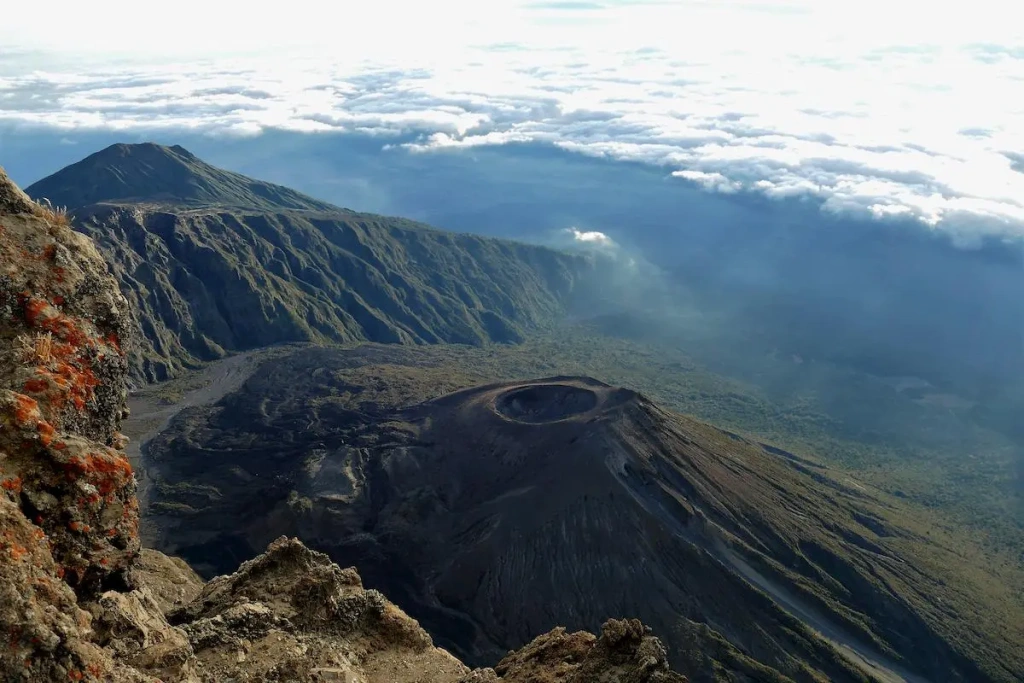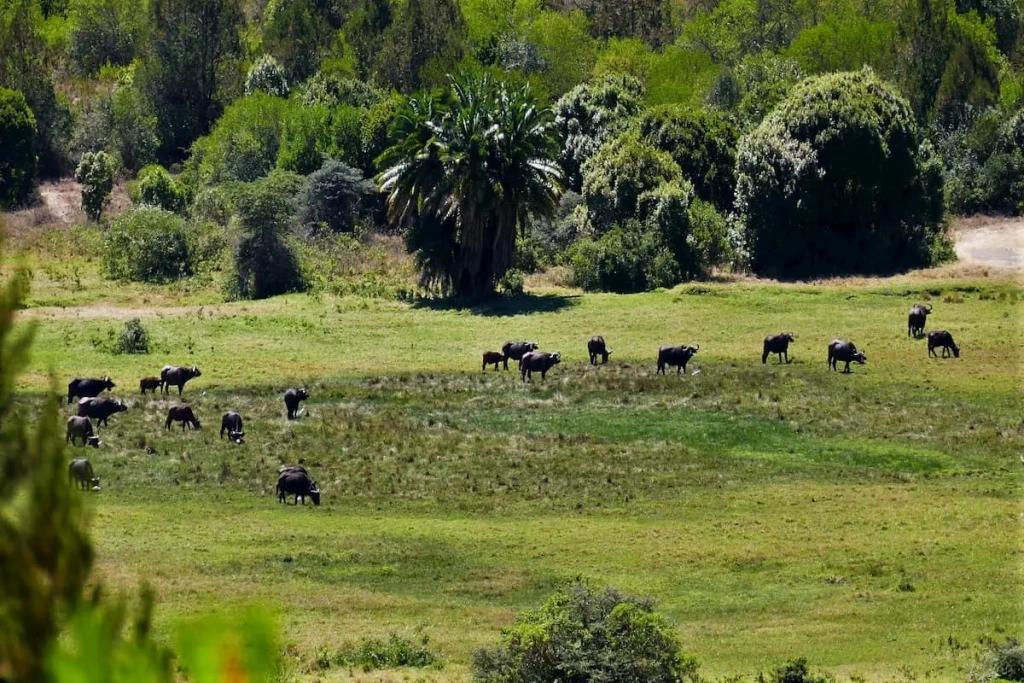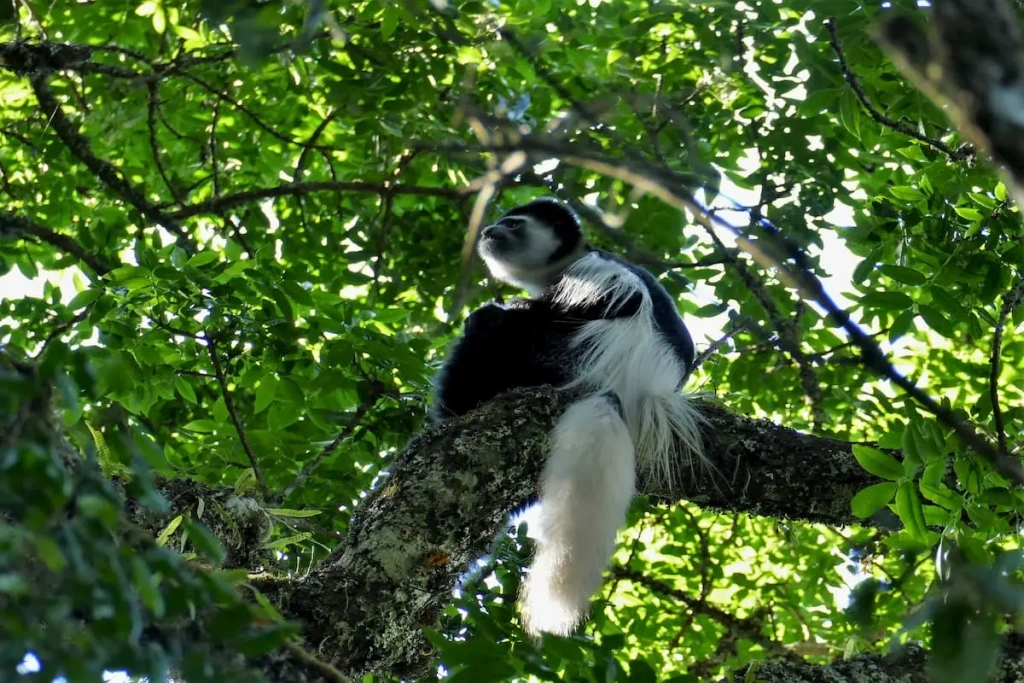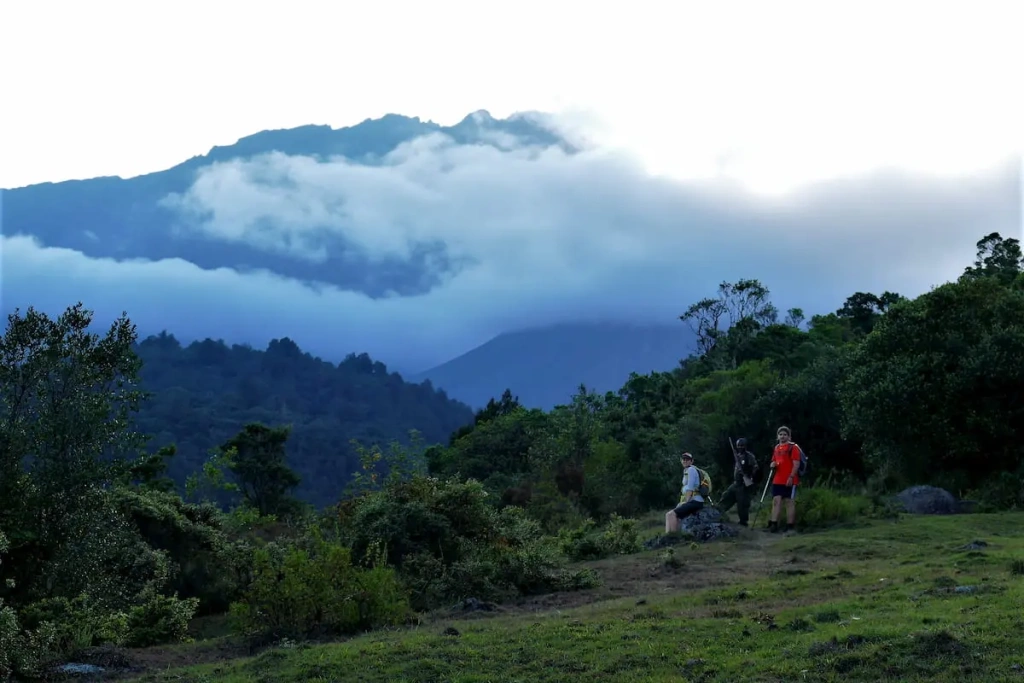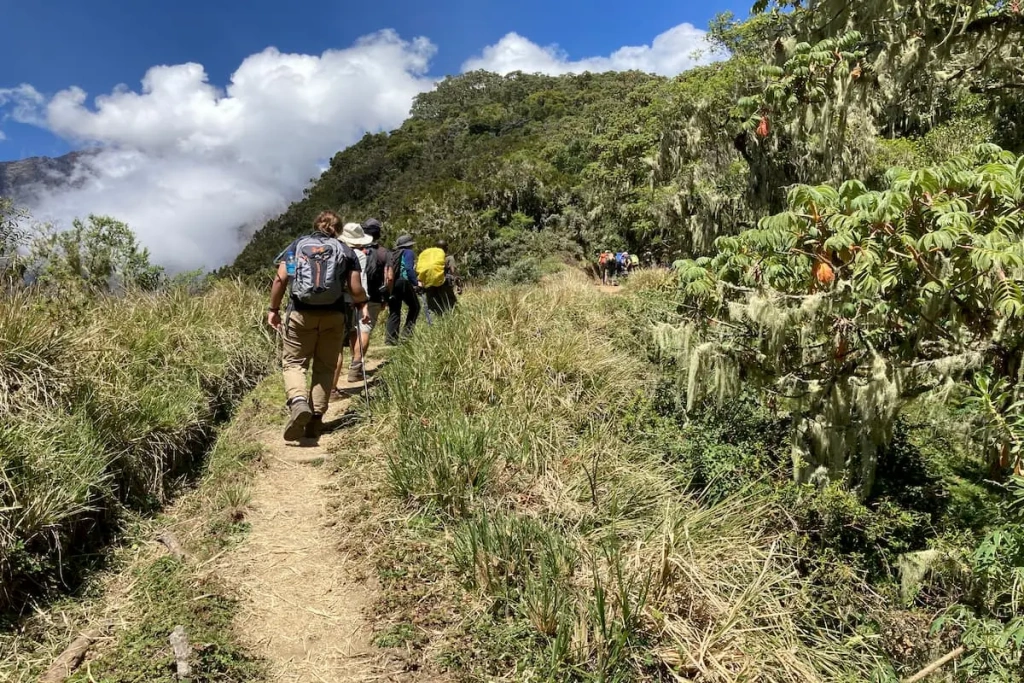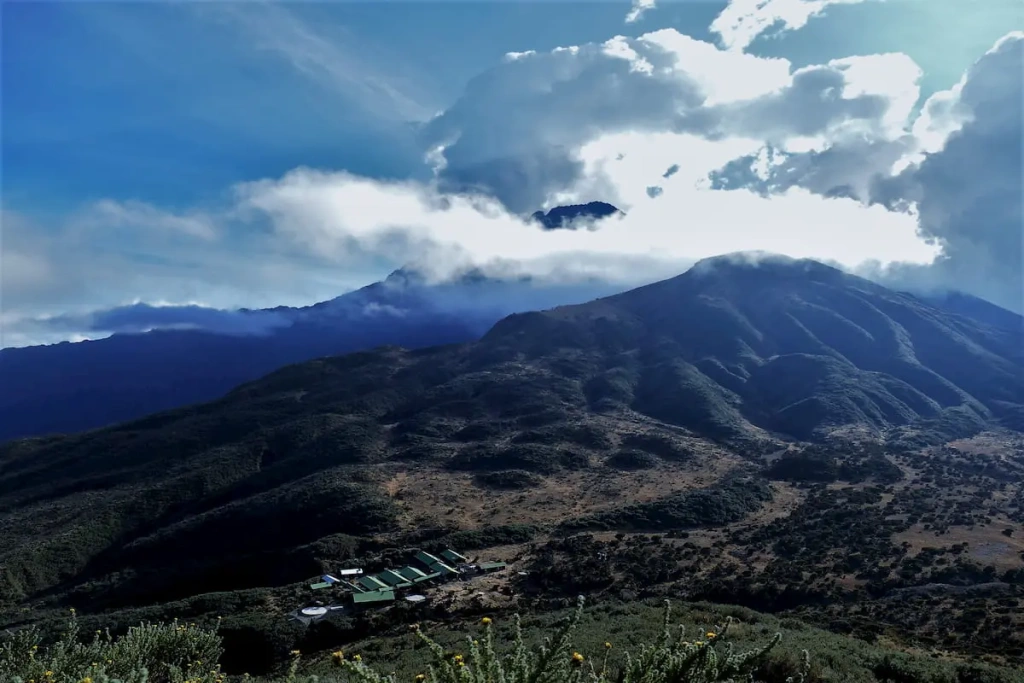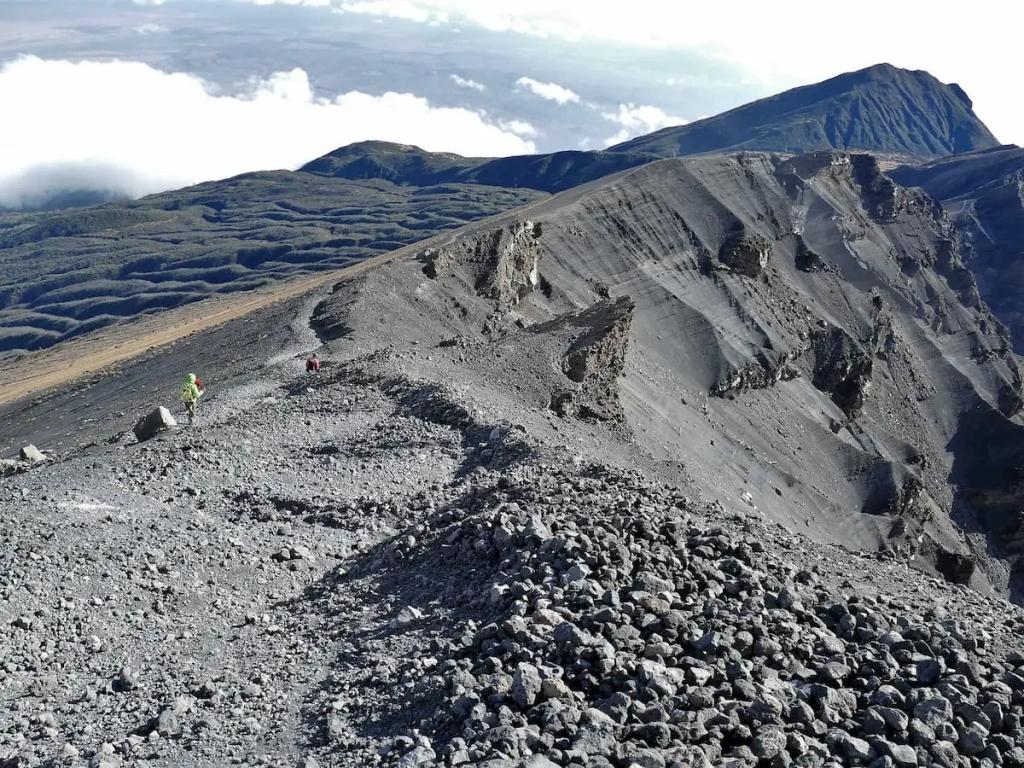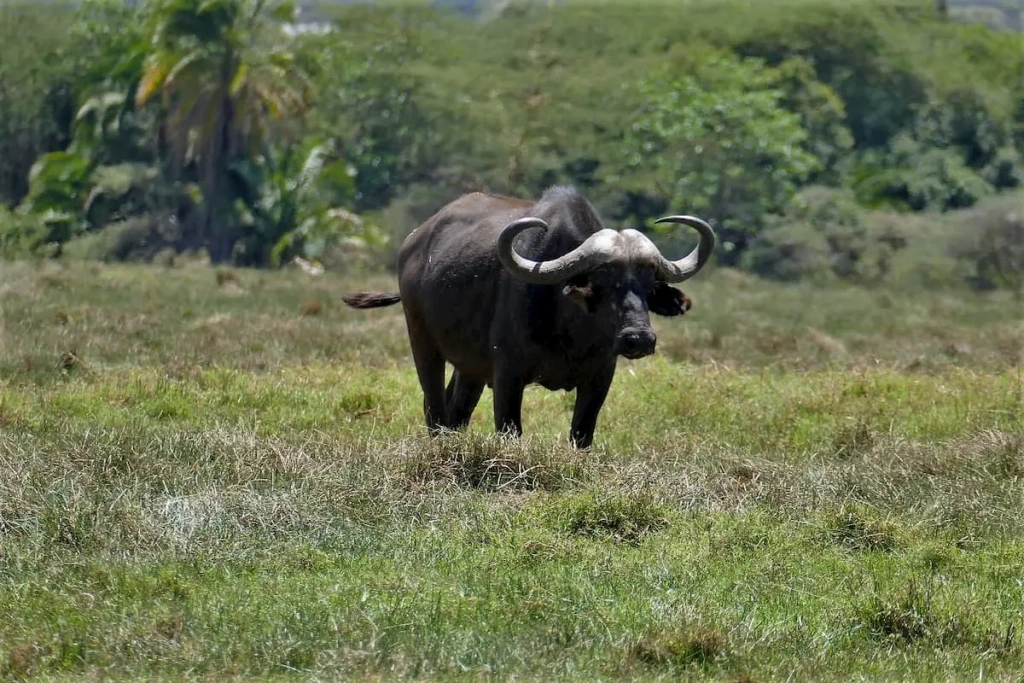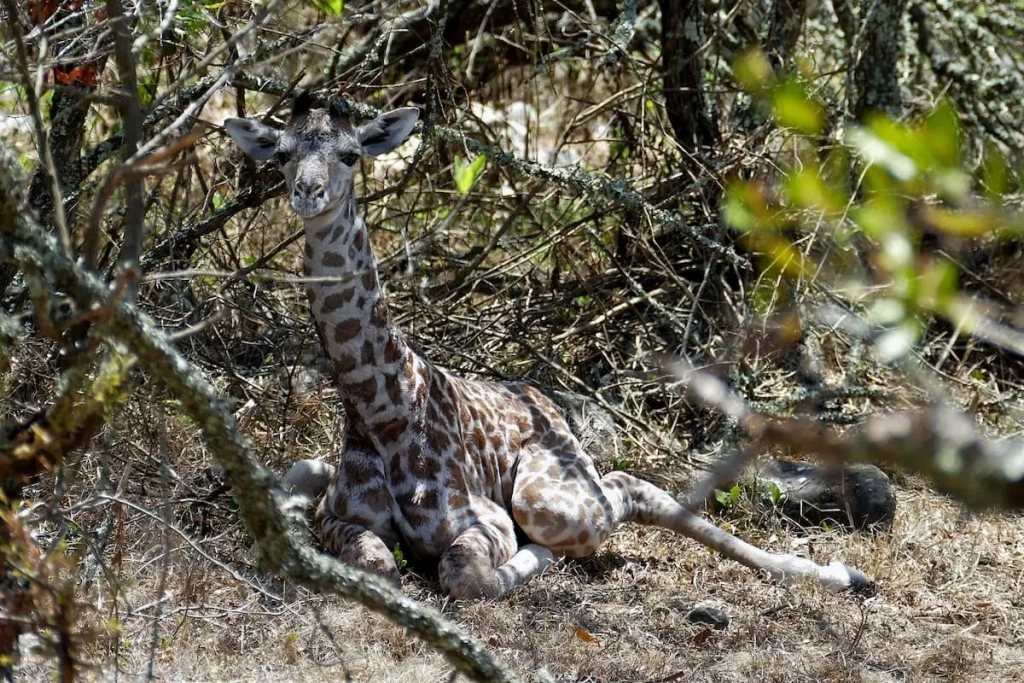Mount Meru
Mount Meru is the most prominent feature of Arusha National Park, standing 14,980 feet (4,566 meters) high. This dormant volcano was once nearly the size of Mount Kilimanjaro, but an eruption (estimated 8,000 years ago) removed the top, leaving only an impressive 5-kilometer wide crater atop this majestic mountain.
Mount Meru may be less popular than the mighty Kilimanjaro, but it offers climbers a fantastic trek in its own right. Meru is often considered a more technical climb than Mount Kilimanjaro, some even argue it is more difficult to reach the top of Meru than Mt Kilimanjaro!
A Meru climb can be completed in 3 or 4 days, compared to a week on Kilimanjaro, so trekkers who are short on time should consider climbing Mount Meru. Some climbers ascend Mt Meru for acclimatization before attempting Kilimanjaro, which is a sensible choice to prepare for Kilimanjaro’s high altitude. Other, savvy visitors want to take advantage of the opportunity to combine a walking safari in Arusha National Park with a mountain trek, which is only possible on a Mount Meru climb. No matter the reason, a Mount Meru climb is an incredible adventure only available in Tanzania.
Mount Meru Trip Report
Day 1: Momella Gate to Miriakamba Huts (10 Kilometers, Altitude: 2,514 m)
Our small team arrived at Momella Gate in Arusha National Park just before lunch. Here we enjoyed our packed lunches while we waited to be assigned a ranger.
Every climbing team must be accompanied by an armed park ranger to ensure their safety, as a large portion of the trek passes through animal habitat
Here we also signed the official registrar and I proudly gave my signature as a true Meru climber. Soon our team started the 10 kilometer hike through Arusha National Park’s highlands.
First, we hiked along the road until we came to the Strangling Arch. This impressive tree has a natural arch through the middle, large enough for a small car to drive straight through the middle! The tree is a perfect place for some photographs beside this natural phenomenon. After the Strangling Arch, we turned off the road into a small forest trail and I felt as though our mountain trek had truly begun.
It was refreshing to walk under the shade of trees and also interesting because we saw many birds (including a Turaco) and several kinds of monkeys - Colobus Monkeys and Blue Monkeys. Our ranger spied a gazelle jumping through the trees and I spotted a dik dik, too. The walk was pleasant, but I didn’t feel like we were gaining any altitude until we stepped out of the forest. Despite that it did not physically feel like much of a climb, when we reached the grassy highlands and stepped out of the trees, we were rewarded with a spectacular view of Arusha National Park. Up above it all, I realized we had definitely reached a higher altitude and were near the camp.
We arrived at Miriakama Huts in the early evening. The long dormitory-style huts were prepared with clean bunks and locking doors for privacy and security. There are nearby bathrooms and solar-lights for hiker’s comfort, as well.
However, you cannot forget that you are still within the wilds of Africa: that night, after we were all safely in our rooms, a Cape Buffalo ventured into the middle of the camp area: how thrilling to see such a massive wild animal grazing just a few feet away!
Day 2: Miriakamba Huts to Saddle Hut (5 Kilometers, Altitude: 3,570)
I woke early and headed to the look-out balcony, located just behind the dining area. After climbing a few steps, I reached the platform that allowed me an ideal view of Arusha National Park and beyond. What a truly beautiful panorama: a pink and purple sunrise above the treeline, with Mount Kilimanjaro rising magnificently out of golden clouds. When climbing Mount Meru, make sure to wake up early at Miriakamba Huts to catch the sunrise, it is one of the most glorious mornings I’ve ever witnessed.
After a hearty breakfast our team was ready to hike. While the second day is a shorter hike, it is steeper and does take more energy than the previous day. It’s sensible to leave early, because the next day is a night climb.
+ Avoid caffeine, if you can. This can help you get a good nap later in the day.
+ Make sure to wear sun protection! The elevation can make you feel cooler, but the sun is still strong up there on the mountain.
The hike was picturesque throughout and diverse; we hiked from alpine forest to dry, grasslands above the treeline. High-altitude plants and unique birds sparked our interest and I didn’t feel fatigued when I arrived at the Saddle Hut. We arrived in time for a hot lunch and had a short rest before summiting Little Meru. It is important to participate in this short acclimatization hike, but it was also well worth it because the scenery atop Little Meru was breathtaking. We caught a glimpse of our coming hike. It was encouraging to see it in daylight, as we would be trekking it in the dark and wouldn’t have the same perspective during the night hike.
Day 3: Saddle Hut to Meru’s Peak (9 km/18 km round trip. Altitude: 4,565 m)
We woke just after midnight and ate a big snack in preparation for the climb. I was so excited that I did not find it difficult to wake and be active at the late hour. It was much colder at Saddle Hut and I was thankful for all of my layers as we began hiking toward the final peak. The first stage was an easy hike up to Rhino Point and it was interesting to look at the rare rhinoceros bones located at this high altitude. From there, the terrain became rocky with large boulders, and soon we reached the next marker: The Chains. This portion of the climb is incredibly steep, therefore, for safety there are a series of chains bolted directly into the rock face. Climbers hold the chains for stability as they move forward. It also gives the sensation of completing technical climbing, which was exciting.
After the chains, we reached the volcanic sand. Here, I was immensely grateful for my trekking poles, as the sand was slippery and I used the poles to help me from sliding back down the few steps I had just taken. I found the trail through the black sand the most taxing of all, thankfully it was dark and quiet and I was able to move forward in a methodical manner.
As the sky was growing lighter, we reached the crater’s edge. I was able to make out the incredible sharp drop to my left and even see the outline of the Ash Cone below, a reminder that Mount Meru is a dormant volcano, with all the aspects of former eruptions. The large peaks ahead were becoming more visible by the minute and each step forward was a promise that we were nearing our final goal.
After 45 minutes of climbing up boulders and reaching small peak after small peak, we glimpsed the Tanzania flag ahead and I knew we were finally at the top. The sight gave me renewed energy and I scrambled on until I reached the sign: “Mt Meru, the Fifth Highest Mountain in Africa”. What a feeling!
We arrived in time for sunrise and it was nothing short of epic. The sun illuminated the entire mountain and all the landscape beyond, while the clouds lit up with the magical colors of the sunrise. Ahead, Mount Kilimanjaro stood mightily, and felt so near that one could imagine simply stretching out their hand and touching it. Behind, the shadow of Mount Meru stretched across the face of the earth, covering the landscape below and evoking a sensation of awe, as I recognized I was standing at the very top of this great volcano.
Hiking back down the mountain was a very different experience in daylight. I felt a surge of adrenaline as I returned through the volcanic-ash (downhill this time), and held the chains once again at the steep rocks.
We returned to Saddle Hut and had a much deserved rest before packing up and heading back down to Miriakamba Hut (5 kilometers). If your team is hiking the 3-day itinerary, you will hike all the way back to Momella gate at this time. I was thankful for our 4th day, because completing the long descending climb in a single day would have been very difficult on my tired knees.
Day 4: Miriakamba Hut to Momella Gate (5 km, Altitude: 1,387 m)
Miriakamba huts felt very different on the descent; new groups of hikers making their way up and beautiful scenery as we hiked down. This trek is a shorter route than the one taken on ascent, (half the distance) and makes for a diverse descent.
We departed in the morning, feeling lighter with each step and enjoyed the cool air in the shade of trees. The unanimously favorite part of the final day is the hike to Tulusia Waterfall and the walking safari.
Here, it is important to walk in close proximity to the armed ranger, because there is a good chance of seeing Cape Buffalo. We did safely pass a herd of these beautiful creatures, grazing in the swampy areas, they eyed us suspiciously and even posed for some great photographs, but did not venture close to us. In the distance, we saw several giraffes enjoying their lunch of acacia leaves and a herd of zebras marching together. At Tulusia Waterfall, we relaxed for a few minutes under the cool spray of the powerful waterfall and recollected all the adventures we had experienced over the past four days.
As we left the waterfall and neared our final destination, Momella Gate, we came across a baby giraffe, sleeping in the shade. She woke up and looked curiously at our team. We were all pleasantly reminded of the privilege to experience Africa in such an intimate manner. Only a Mt Meru trek allows you to experience Arusha National Park in such an immersive way: trekking a volcano; capturing breathtaking scenery; and interacting with Africa’s incredible wildlife.
It was the perfect end to a fantastic climb.
Notes about climbing Mt Meru
Rangers
Rangers are required for most climbs in Tanzania. Teams climb in national parks with real wild animals - it is a great adventure but the dangers must be considered as well. For this reason, each climbing team is assigned an armed Park Ranger to accompany the team. Our ranger, Julius, was a part of our team and felt like a friend throughout the climb. He even helped carry the pack of a tired hiker and encouraged me when I was fatigued.
Thankfully, we never did run into any dangerous animals during our trek. On the last day we saw a herd of Cape Buffalo a safe distance away, but it was still reassuring to know that our ranger was there in case we needed him.
Guide
It is a requirement to climb Mt Meru with a qualified guide. The final summit is a night climb and you surely won’t be able to find your way alone in the dark! A portion of the ascent uses chains secured to the mountain’s face - this sort of technical climbing is essential to attempt under the supervision of a true mountain guide.
Huts
All climbing teams sleep in permanent huts during their climb. The first huts are Marikamba Huts (2, 514 m) and the second night, teams sleep at Saddle Hut (3,570 m). These are comfortable accomodations with locking doors for privacy and security. Huts are outfitted with solar lights and mattresses.
Huts help to preserve Mt Meru’s environment and also ensure climbing teams have access to the most important amenity: water. Thanks to this, teams do not have to haul water or tents up the mountain.
Climbing Team
Your climbing team will consist of your guide, ranger, cook and porters. The cook prepares all your meals and a snack for the final summit night. The porters carry everything up the mountain. Tanzania has regulations to protect and uphold the rights of porters, some of the regulations ensure that no porter carries over 25 kilograms. Most teams require 2-3 porters for every climber on your team. This is because they carry all of the food, a camping stove and fuel, as well as your luggage, up the mountain. Porters required for a Mt Meru climb are almost always less than a Kilimanjaro climb because there are no tents to pack, and fewer days involved in climbing.
Number of Days
There are two options for climbing Mt Meru (but only one route up): 3-days or 4-days. The number of ascending days is identical, the only difference is on the descent. Those who complete the 3-day itinerary have a very long day descending the entire mountain in a single day (all on very little sleep). This can be especially hard on the knees and is a fatiguing experience, especially after just climbing to the top of Mt Meru early the same morning.
The 4-day itinerary, on the other hand, allows for a longer rest after reaching the top of Mt Meru, and then a partial descent. Teams spend an extra night at Miriakamba Huts and complete the final trek down at a leisurely pace the next morning. This also allows for a wonderful walking safari and hike to the beautiful Tululusia Waterfall in Arusha National Park.
The 4-day trek is recommended because it is better for your knees, breaks up the 33+ kilometer trek over two days, and includes a walking safari at an ideal time of day.











